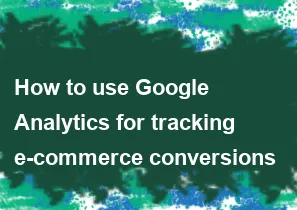How to use Google Analytics for tracking e-commerce conversions

Using Google Analytics for tracking e-commerce conversions is a valuable strategy for understanding your website's performance and optimizing your online store. Here's a step-by-step guide to set up e-commerce tracking in Google Analytics:
1. Create a Google Analytics Account and Property:
- If you don't already have a Google Analytics account, sign up at Google Analytics.
- Create a new property for your e-commerce website.
2. Install Google Analytics Tracking Code:
- Obtain the tracking code from your Google Analytics account.
- Add the tracking code to all pages of your website, typically in the
<head>section of your HTML.
3. Enable E-commerce Tracking:
- In your Google Analytics account, go to the admin section.
- Under the Property column, click on "E-commerce Settings."
- Toggle the "Enable E-commerce" switch to ON.
4. Implement Enhanced E-commerce Tracking (optional but recommended):
- Enhanced E-commerce provides more detailed insights into user behavior. If you're starting fresh, consider using Enhanced E-commerce.
- Enable Enhanced E-commerce in your Google Analytics property settings.
5. Set Up Goals:
- Goals help you track specific actions users take on your site. Define e-commerce-related goals, such as "Completed Purchase" or "Add to Cart."
- In your Google Analytics admin, under the View column, click on "Goals" and set up your desired goals.
6. Add E-commerce Tracking Code to Purchase Pages:
- Implement additional code to track e-commerce transactions.
- Use the
ecomm_prodid,ecomm_pagetype, and other relevant parameters to track product details and transaction information. The exact code depends on your platform.
7. Test Your Setup:
- Make a test purchase on your website and ensure that the data is being recorded accurately in Google Analytics.
- Verify that the goals and e-commerce tracking data are being tracked as expected.
8. Monitor Reports:
- Give Google Analytics some time to collect data.
- Explore the various reports under the "Conversions" and "E-commerce" sections to gain insights into user behavior, conversion rates, and revenue.
9. Set Up Funnel Visualization (if applicable):
- If you have a multi-step checkout process, set up a funnel to track the steps leading to a conversion. This can help identify potential bottlenecks.
10. Regularly Review and Optimize:
- Periodically review your Google Analytics reports to identify areas for improvement.
- Use the data to optimize your website, marketing strategies, and user experience.
Note:
- Google Analytics may have updated features or changes after my last training data in January 2022, so always refer to the latest documentation for the most accurate information.
- If you're using a specific e-commerce platform (e.g., Shopify, WooCommerce), there might be platform-specific integrations or plugins available to simplify the setup process.
-
Popular Post
- How to optimize for Google's About This Result feature for local businesses
- How to implement multi-language support in an Express.js application
- How to handle and optimize for changes in mobile search behavior
- How to handle CORS in a Node.js application
- How to use Vue.js with a UI framework (e.g., Vuetify, Element UI)
- How to configure Laravel Telescope for monitoring and profiling API requests
- How to create a command-line tool using the Commander.js library in Node.js
- How to implement code splitting in a React.js application
- How to use the AWS SDK for Node.js to interact with various AWS services
- How to use the Node.js Stream API for efficient data processing
- How to implement a cookie parser middleware in Node.js
- How to implement WebSockets for real-time communication in React
-
Latest Post
- How to implement a dynamic form with dynamic field styling based on user input in Next.js
- How to create a custom hook for handling user interactions with the browser's device motion in Next.js
- How to create a custom hook for handling user interactions with the browser's battery status in Next.js
- How to implement a dynamic form with dynamic field visibility based on user input in Next.js
- How to implement a dynamic form with real-time collaboration features in Next.js
- How to create a custom hook for handling user interactions with the browser's media devices in Next.js
- How to use the useSWRInfinite hook for paginating data with a custom loading indicator in Next.js
- How to create a custom hook for handling user interactions with the browser's network status in Next.js
- How to create a custom hook for handling user interactions with the browser's location in Next.js
- How to implement a dynamic form with multi-language support in Next.js
- How to create a custom hook for handling user interactions with the browser's ambient light sensor in Next.js
- How to use the useHover hook for creating interactive image zoom effects in Next.js